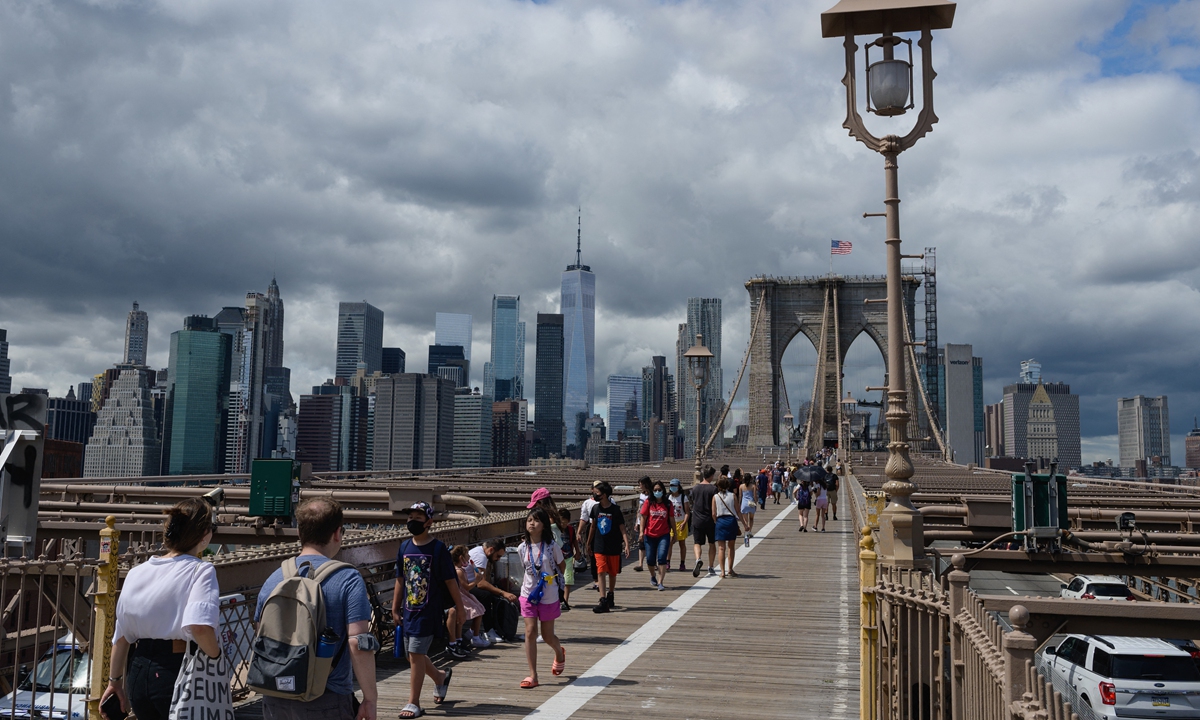
People walk over the Brooklyn Bridge of Manhattan in New York City, the US on Thursday. Photo: AFP
When Rev. William H. Lamar IV used to preach in Florida, he would take his predominantly Black congregation outside to publicly display the church's connection to the community - until it became a health risk because of worsening heat.
"It was better to stay inside and be a little less hot than to go outside and be blazing and have no cover," recalled Lamar, now pastor of the Metropolitan African Methodist Episcopal Church in Washington DC.
That contrasted with Lamar's tours of "wealthier, whiter" neighborhoods where he found people jogging beneath the shade of lush trees and frequenting parks and other green spaces.
"Our infrastructure continues to create these inequities that give more to the wealthy ... and continue to extract in life and treasure from other communities," he told the Thomson Reuters Foundation.
The $1.2 trillion, 2,702-page infrastructure bill moving through the US Congress - which was passed by the Senate last week - aims to help redress such imbalances.
It contains a new "Healthy Streets" program geared toward communities that are frequently left behind in efforts to mitigate so-called "urban heat islands," where concrete-heavy city landscapes push up temperatures.
The legislation allows states and local governments to apply for grants of up to $15 million to deploy "cool" and porous pavements, which reflect heat and facilitate water runoff, and boost the tree canopy in disadvantaged areas, among other measures.
"It's a good beginning, but it's nowhere near everything we need," Lamar said, expressing hope that the "federal largesse" could help spur more action by local governments.
'Climate gentrification'
Efforts have been underway for some time in cities to reduce the effects of rising heat fueled by climate change.
In California, new buildings must comply with strict "cool" or reflective roof requirements, while San Francisco demands that most set aside part of their roof space for solar panels or "green" features like vegetation and gardens - which can also help buildings in other cities meet energy efficiency standards.
Los Angeles famously started painting some of its streets white years ago in a bid to reflect the heat.
But neighborhoods that get upgrades to boost their resilience to a hotter climate can end up crowding out the poor as their popularity rises - a process known as "climate gentrification" - while many beneficiaries already live in higher-income areas insulated from the worst effects.
About 18 percent of the tree canopy in Los Angeles is concentrated in four neighborhoods - the tony Pacific Palisades and Brentwood areas, along with Shadow Hills and Los Feliz - that are home to less than 1 percent of the city's population, according to CAPA Strategies, a data analytics group.
And all too frequently a community is supposedly "improved" only to see speculators swoop in and drive up rents and property values, said Anthony Rogers-Wright with the nonprofit New York Lawyers for the Public Interest.
"Then people are either forced to move because they can't afford new property taxes or they can't afford the rents anymore," he said.
"The road to bad policy is paved with good intentions," he added.
Promoting equity
The "Healthy Streets" program in the infrastructure bill aims to avoid this by requiring applicants to specify how the projects will benefit disadvantaged and low-income communities, where at least 30 percent of residents live below the poverty line.
Local governments that are awarded the funds can also use them to conduct "equity" assessments by mapping tree canopy gaps, flood-prone locations, heat island hot spots, and the extent to which those risks overlap with lower-income areas.
"You can overcome many generations of structural inequality, including racial inequality ... through investing in lower-income areas and moving from dark, impervious surfaces to reflective surfaces," said Greg Kats, founder and CEO of the Smart Surfaces Coalition, which advocates for such technologies.
Baltimore, Maryland would see a significant return on investment with a citywide plan involving cool roofs, solar panel installations, reflective pavements, and more trees, according to a report Kats' group released in July.
A $5 million investment in Madison-Eastend, a lower-income neighborhood of east Baltimore, would generate a higher than 11-to-1 return through effects like job creation, it projected.
Low-income residents also stood to reap a greater share of the resulting health benefits from lower air pollution, energy savings on less air conditioning, and new jobs, it added.
Baltimore City Councilman Mark Conway said the report showed that broad adoption of smart surfaces would help "redress long-standing environmental injustice."
Economics speak louder?
The new program presents an opportunity to take small steps forward amid broader calls from environmental justice advocates for at least $1 trillion in annual federal spending to combat climate change.
"This is a potential panacea moment if we do it correctly and intentionally," said Rogers-Wright, environmental justice director for the New York lawyers group.
"We have to make sure that these improvements are done with the buy-in of the community," he added.
Additional funding for studies to work out where to steer new projects, given the expense of major retrofits, would be welcome, said Saleem Chapman, chief resilience officer for the city of Philadelphia.
It has been working on a pilot to coat streets with coolants in a bid to tackle what can amount to a 22 F (-5 C) peak temperature difference between neighborhoods.
"It's going to be really hard to scale these projects - we've spent two years and we're probably going to do maybe a mile of actual roadway," said Chapman.
Rev. Lamar said advocates would need to push the case for more smart surfaces - and tailor their pitches to focus on the expected cost savings and financial gains if necessary.
"History bears this out - that America is more moved by economics than it is by justice," he said.
Reuters
